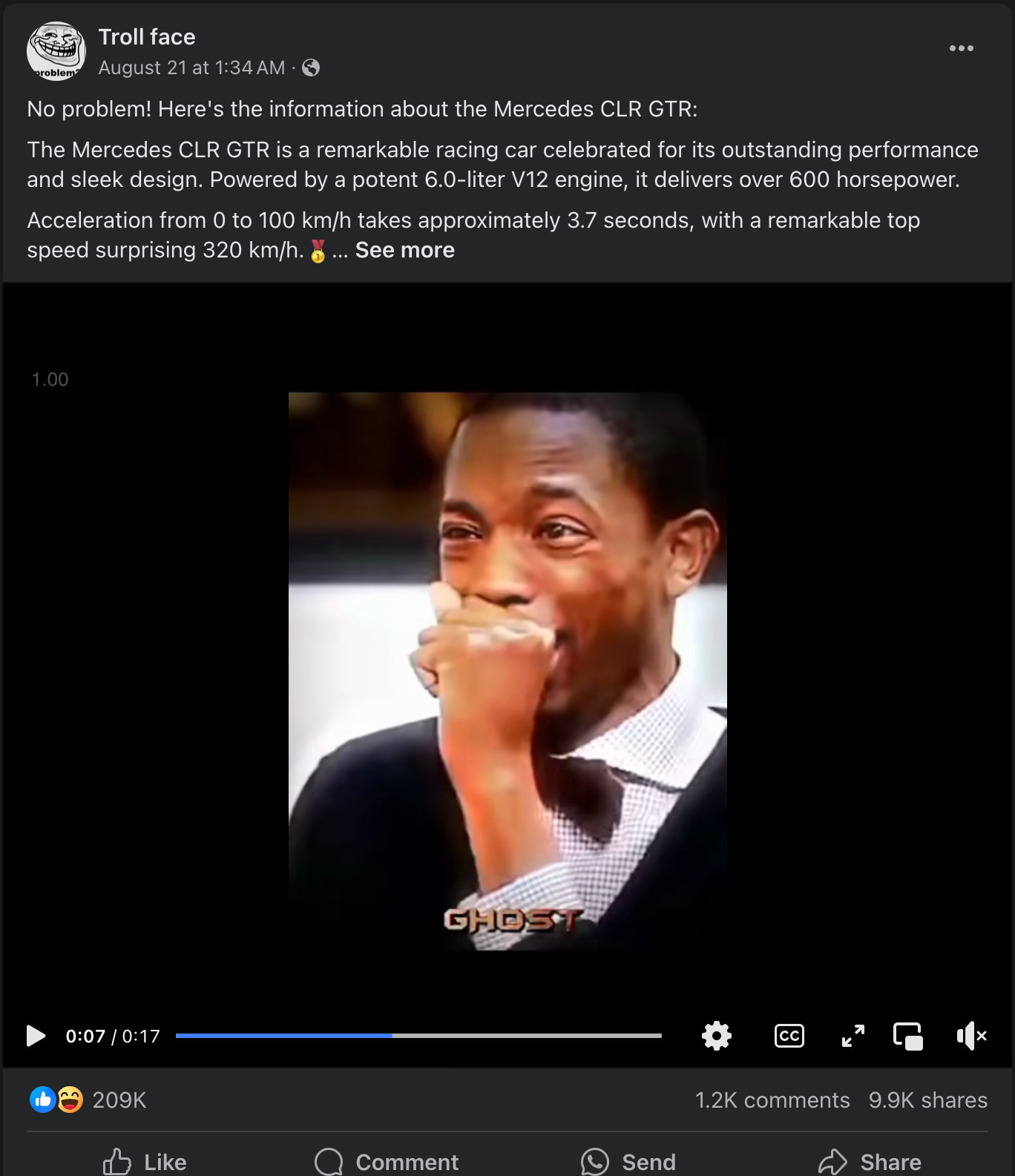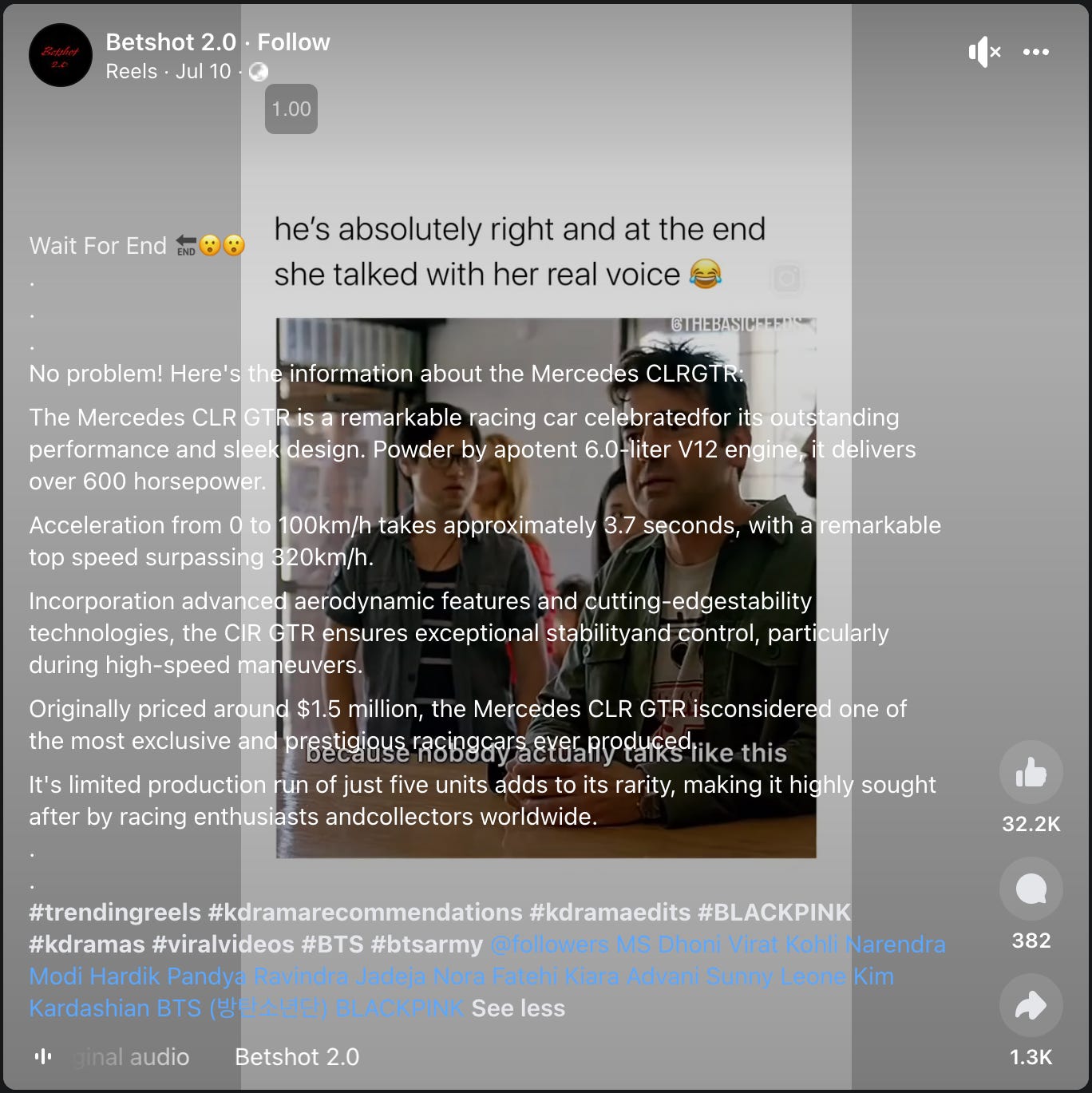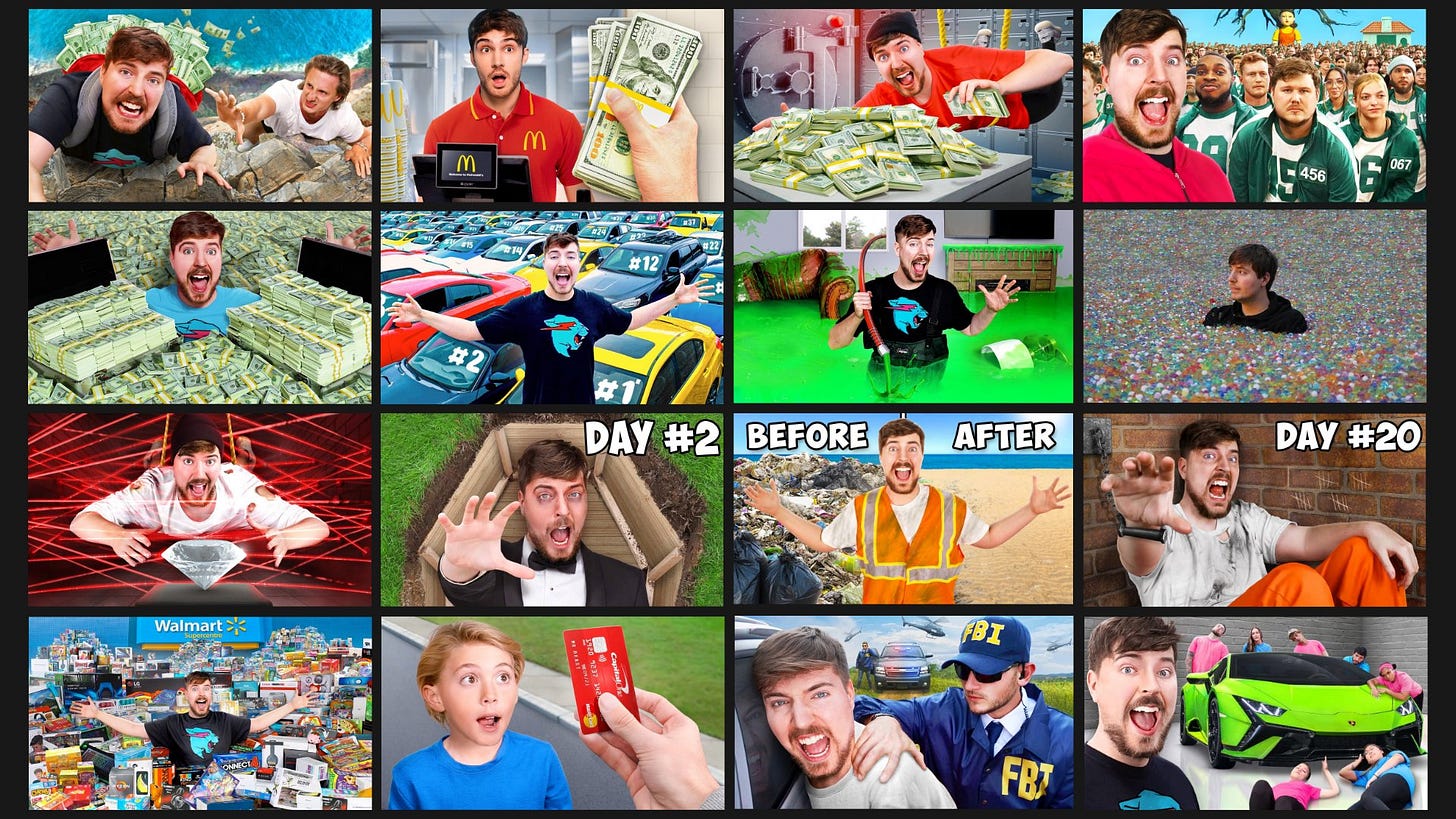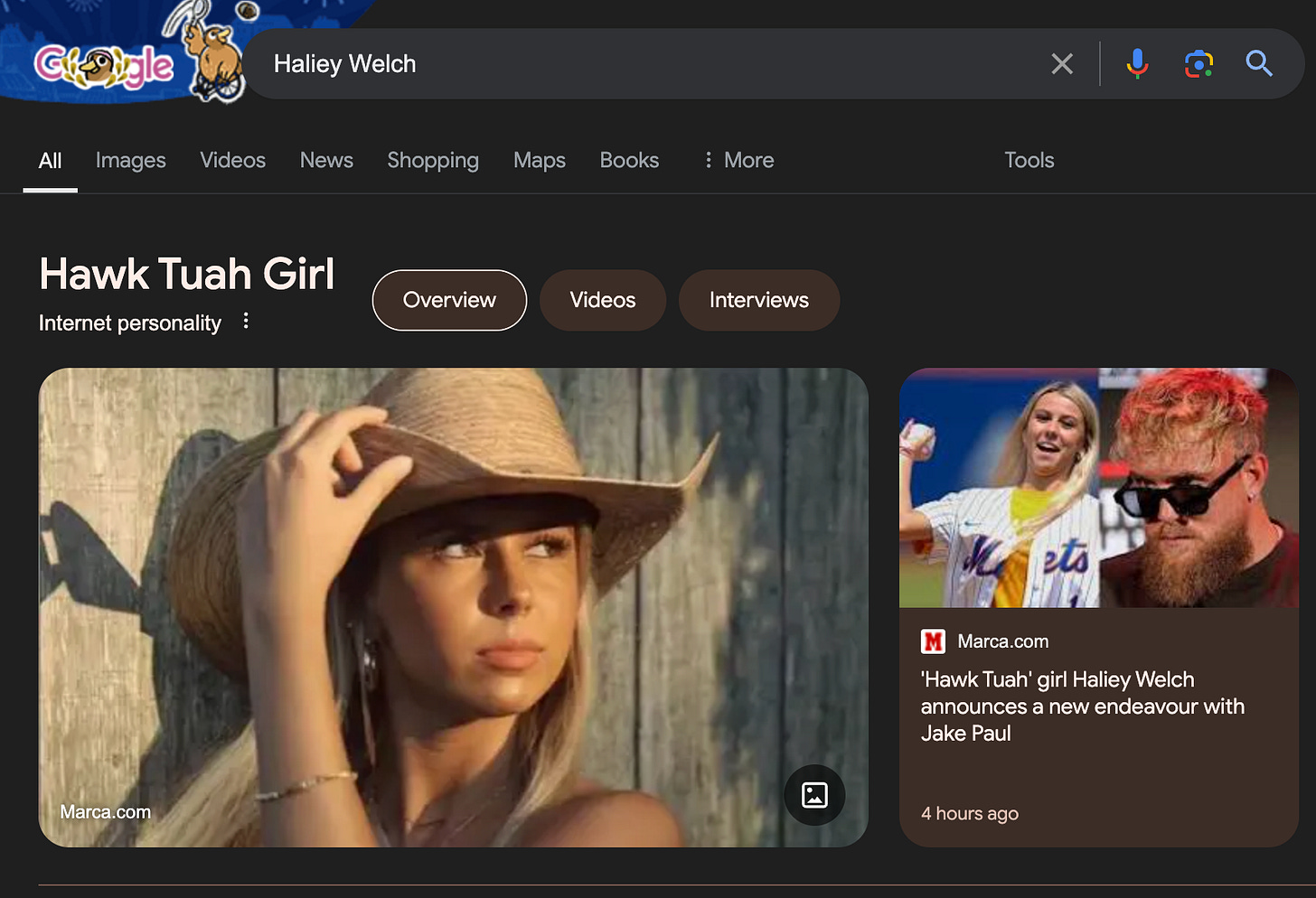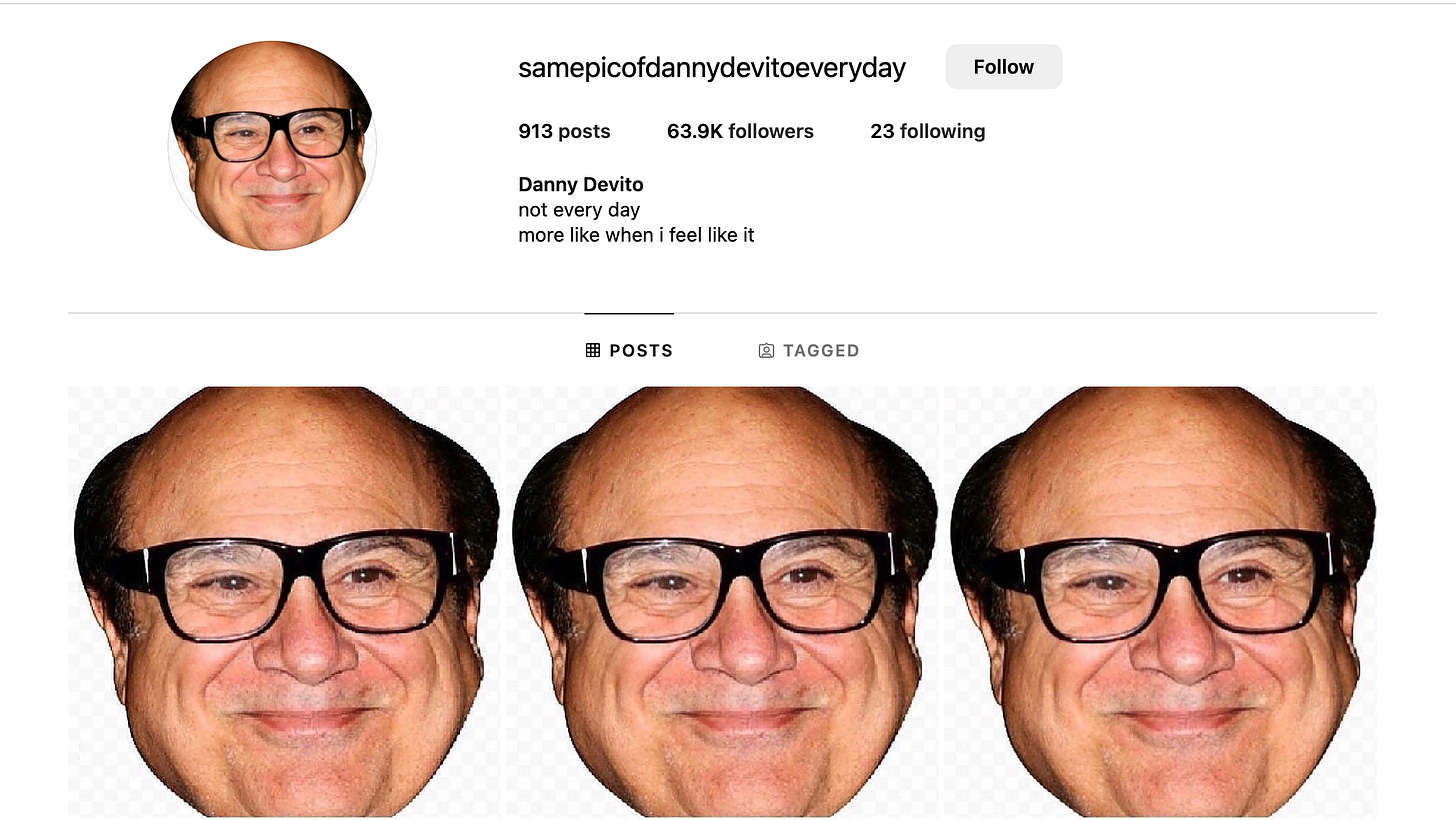Have clips killed the internet?
May the Mercedes CLR GTR be on your side
We’re all familiar with the clip culture we live in today, but one fascinating thing I recently discovered is the widespread use of specific copy pastas on these clips.
If you're on TikTok, Instagram Reels or Facebook, and you haven't come across the infamous BMW, Tesla Cybertruck or Mercedes CLR GTR copypasta captions, you're quite lucky, but I can guarantee you that you will come across something like these if you're on these platforms long enough -
(The next paragraph is clearly AI generated, so you can just skim it instead. It's also factually incorrect since no such car exists, but some copy pastas can be correct as well.)
"No problem Here's the information about CLR GTR: The Mercedes CLR GTR is a remarkable racing car celebrated for its outstanding performance and sleek design. Powder by a potent 6.0-liter V12 engine, it delivers over 600 horsepower.🔧 Acceleration from 0 to 100km/h takes approximately 3.7 seconds, with a remarkable top speed surpassing 320km/h. 🥇 Incorporation advanced aerodynamic features and cutting-edge stability technologies, the ClR GTR ensures exceptional stability and control, particularly during high-speed maneuvers. 💨 Originally priced around $1.5 million, the Mercedes CLR GTR is considered one of the most exclusive and prestigious racing cars ever produced. 💰 It's limited production run of just five units adds to its rarity, making it highly sought after by racing enthusiasts and collectors worldwide. 🌎"
Similar posts about BMW, Hyundai and other cars exist and people use these as captions, but what's remarkable is that these captions are 100% irrelevant to the posts.
Here are some screenshots of the posts from Facebook -
Now, what is happening? WHY ARE ALL THESE PEOPLE SHARING POSTS WITH THE SAME CAPTION, EVEN ON UNRELATED PICTURES?
Why are there millions of posts like these, EVERY SINGLE DAY?
Even X.com is not immune to this. Just search for “no problem here's the information about clr gtr” on X and you’ll see hundreds of posts with this caption posted within the last hour.
I don’t have TikTok installed, but I asked my friend who does, and she said she’s seeing the same thing.
Whichever platform you’re on- Instagram, Facebook, X, TikTok, you’re never safe from the Mercedes CLR GTR.
It’ll haunt your feed, reminding you that nothing is real. It’ll haunt your dreams knowing that the Internet you once cherished has died and you couldn’t do anything to save it.
The Mercedes CLR GTR is more than just a copypasta.
It’s a war cry against originality, creativity & freedom. It’s a statement of victory from the algorithmic abyss. It’s raw competition unmasked in all its glory, fighting for your most valuable resource - time, in the most obnoxious and annoying way imaginable.
The Mercedes CLR GTR will follow you everywhere. The Mercedes CLR GTR knows what you like, what you don’t like, and it’s there every time you open your phone.
At this point, just ride me over with it.
II.
Ok, in all seriousness, what is happening?
The running theory is that car guys watch a lot of short clip content online like TikToks and Reels, so every account figured out that the quickest way to get views is to add unrelated captions of cars to their content.
The algorithm picks this up and shows it to car guys. If this theory is true, it must also be true that car guys are terribly slow to scroll away - because if they did, the posts wouldn’t be boosted. So, car guys are being sent these clips on all platorms, they’re watching them - which signals to the algorithms that this is content worth spreading, which it is then doing and thus, you’re seeing these clips take over.
This sounds pretty harsh to car guys, so I wouldn’t be surprised if there are content farms in third worlds specifically dedicated to increase the watch time on such clips. This doesn’t explain why the content farm would watch clips from unrelated accounts not paying them for views, but since tens of thousands of accounts are doing this, maybe they are?
Either way, this paints a pretty damning picture for cyberspace today and it warrants a discussion about where we all are heading in world, and to answer the question whether clips have killed the Internet, we must dig deeper.
The average user spends 58 minutes on TikTok each day. The average time spent on Instagram is 33 minutes per day. For X & Snapchat, the time spent is roughly 30 minutes. All these apps are serving short form clips, sometimes exclusively short form clips, like TikTok. YouTube, which also has YouTube shorts, claims that users spend 48 minutes on the app everyday.
If you add it all up, that’s close to 4 hours per day, but it’s safe to assume that the average user spends 30-60 minutes on their preferred app just scrolling through short clips.
If you want popular attention, and you’re not available as a 30-60 second clip, it’s going to be hard to reach people.
People have realized this and are leveraging it in the most unique of ways, and this is what leads to content with irrelevant captions such as above, but it also leads to things like shockvertising (Shock + Advertising) -
I couldn’t find a better shock-ad because I mute and block every account that serves them to me, but current shock ads are actually more effective than what you see above, where they’ve realized that you must capture the user’s attention within the first 5 seconds.
Thus, most shock ads, today, are people getting hit by cars or jumping off cliffs or getting punched in the face, which transitions right before the impact to someone talking about a product.
Ads that you literally can’t look away from are here, and they’re not getting more expensive to create.
This is the same technique that YouTubers use when they cram as much information in the first few minutes, setting up the video, using quick cuts, and make sure that you’re “hooked” enough to watch the whole thing.
Mr. Beast takes this optimization to the extreme, where he starts with the thumbnail (the first a user sees and decides to click on a video), and has a six person team dedicated to just thumbnails, actively making and testing hundreds of thumbnails for him for each video. That’s how much work is put in for each second of your attention, and the result is not as aesthetic as you’d expect -
Regardless of how you feel about the thumbnails, it’s undeniable that billions of views have arrived just from these thumbnail optimizations, and just like the Mercedes CLR GTR, other YouTubers simply decided to do what’s already working -
Monkey see, monkey do, and as former monkeys we’re always going to see people just adopt the best way to get attention at any given time. In the internet of clips, this involves creating clips with extreme precision, where no seconds are wasted and every moment is optimized for your attention.
Here’s the latest Mr. Beast short with 55 million views -
It’s perfect, from the text and timer that holds your attention, to preparing the hook, to finally giving you the pay-off. You can’t look away, no matter how much you try - once you’re in, you’re in.
While these clips are mostly harmless, there’s an aspect of clips that may not be.
Social media rewards rage and anger, outbursts and outrage, as these are the most important emotions that fuel engagement.
Very soon, a large number of YouTubers will figure out how to leverage this simple fact.
Prank shows will become as common and as violent as ever, and it’ll be difficult to walk down the road without someone or the other filming themselves and trying to get a reaction out of you. Most will tow the line, going out of their ways to reward you if you find them too violent or annoying, but beginners who are influenced by them will not be so wise.
Of course, these will be transitory events.
Vloggers who prank and beat up people in the name of content can only do so till there are people around them, and just like a rude podcaster cannot be successful as there must be sufficient kayfabe involved to make it work, miscreants using social media to film harming others can’t be successful for too long. Some of them will be, and that will influence others to try, but that’s the worse of it.
III.
It just might be time to consider the bright side of this collective addiction to short-form clips that our species participates in.
Clips today, by there very nature, require very little individual attention to go viral and thus, we’re evolving into a culture where viral clips dictate the public discourse.
Here’s where just 30 seconds is enough to make someone famous, where livelihoods may depend on how many engaging clips you can put out, because while you’re not - you’re competitor is, and this is where the clips you watch and/or pass along to your friends or feed, mimetically lives on having fulfilled its purpose.
Clips are also lower effort, unless you’re Mr.Beast-ing it with the granular optimization, and a clip of a simple candid interview on the street can change people’s lives.
Hailie Welch, who even google describes as Hawk Tuah girl, is one such example -
Famous for describing how she’d “spit on that thang” in a random street interview that went viral, she currently has over 2.5 Million followers on Instagram.
In comparison, the most popular substack “Letters from an American” has less than half that many free subscribers.
Scott Alexander, who writes two to three essays every week, has around 100k subscribers, and he has been doing this for over 10 years.
So effort is the wrong metric for our clipped culture here.
Here’s a question for you -
If I posted this essay again tomorrow, would you read it? If I posted this essay again and again, every single day, would you still subscribe to me? The answer is hopefully no.
There are some accounts which are very popular on different platforms who just post the same clip everyday. Just search with “everyday” or “same posting everyday” on your favorite platform and check out the accounts -
Usually, these accounts stop after a while and new accounts posting the same picture or video take over. It’s a sweet gig when it works, and we never see the accounts that don’t make it big, but it’s tremendously low effort.
So, effort, as it stands, has nothing to do with reach.
If it did, everyone on Substack would have millions of subscribers, but that’s not the case.
But it also doesn’t mean that clips are killing the Internet.
IV.
If anything, the proliferation of clips as the dominant medium means we’ve collectively discovered just the right method that anyone can use, regardless of your intelligence or income, to grab someone’s attention with the least effort possible. All you need is a camera for yourself, or someone else pointing a smartphone camera at you.
Unless AR/VR brings in a new medium that is easier and more accessible, things are going to remain this way.
That’s okay, because now, you know the rules of the new internet.
You can consume or spread clips, like everyone else is. Or, just like the people in previous generations who chose to read books over watching television, you can go on Substack, the cozy web, seek out books, niche subreddits & discords, and the great part of all that is - whatever you discover, there’s probably a video-clip version of that niche as well. The internet lives on.
It’s dead if you consider bots and spam as something that doesn’t add value, and it’s dead if you consider the hawk tuah girl as a phenomenon as something that never should’ve gained mass attention, but that’s the wrong way to look at it.
It’s alive, more alive than it has ever been, and the competition for your attention is so fierce that bot accounts are using irrelevant copypastas to try to get a second of your time. It’s a great thing that people are doing this, that independent creators like Mr. Beast has hired dozens of people just to figure out how to optimize the first 5 seconds of a video to get you to view a 30 second view. In a different time, such power of influence could’ve been gated but we’re in the better timeline. A small annoyance is all we have to accept in exchange for such leverage and freedom.
We’ve all heard stories of people’s lives being changed because of a clip. Here’s a clip of Matt Rife who owes his entire standup stardom to one clip going viral -
He explains the whole process very well, that prominent marketers already understand. One clip goes viral - everyone else checks your other stuff, gets to know you, and soon enough, you’re a household name and selling out stadiums.
From nobody to somebody, all because of a 30 second clip, and the playbook to how to achieve it is right there.
This playbook is similar in all industries, like in self publishing, where independent authors are advised to “have a backlog” and “write in series”, where if any novel goes viral, you will get readers all your previous books, and today, the best place to promote your book is, you guessed it, TikTok.
BookTok, as it’s called, is so infamous for driving sales to books that TikTok is considering starting a publishing arm to capture some of the value away from Amazon.
I recently ventured into independent gaming, and the marketing advice is the same. Don’t die after releasing your first game, because that definitely won’t be successful, but if your second or third game is - you’ll get gamers checking out the first.
Again, you don’t have to consume TikTok, X, Instagram Reels, or YouTube shorts. You’re perfectly fine here consuming intellectual content that nourishes your soul and dismissing all such clip content as brain-rot.
But if we don’t acknowledge the opportunity space this provides, the ephemeral cut-throat competition for attention where anyone can participate, the infinite ways to unlimited leverage for the average user with just a smartphone, we’re being dishonest.
It’s fine to not consume a form of content for our own sanity, while also acknowledging its perks. And it’s only when you acknowledge its perks that you realize that the dead internet is not going to arrive any time soon. Bots pretending to be humans couldn’t do it, as spaces that don’t allow bots can or would exist. Viral clips are viral precisely because they reach real people who spread it on.
So, this isn’t an advice to start posting clips on TikTok and everywhere else to get noticed. But the fact that you can do that, and after a mediocre streak, strike gold, where people who never knew you would suddenly be your fans, proves that the internet is at its best right now.
This isn’t something you’d hear from mainstream media, where TikTok and social media are vilified for being the reason for numerous ailments from teenage anxiety to political division, and those may be vital reasons to check these companies, but they’re a shining proof that the Internet that we know is far from a wasteland of bots that cynics would have you believe.
There are more people online than any other time in history. More places to visit, more communities to join, more things to do, see and experience than any other time in the web’s history. It has its problems, it hasn’t lived up to its cypherpunk roots, there’s a widespread issues of moderation, censorship & sybil-resistance, where it’s only learning to tackle the emergent issues of AIs pretending to be humans.
But the internet isn’t dead.
It’s alive, more alive than it has ever been, and it’s only going to get better from here.



